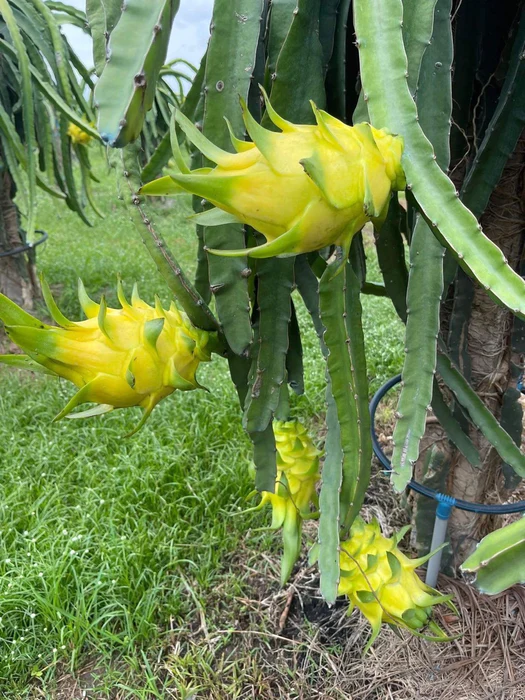
Yellow Dragon Fruit
Yellow Dragon Fruit (Hylocereus megalanthus)
The Yellow Dragon Fruit, also commonly known as the Yellow Pitaya, stands out with its vibrant yellow skin and sweet, juicy flesh. It belongs to the cacti family, and while it's primarily cultivated for its fruit, the plant itself also makes for a striking ornamental specimen.
Common Names:
Besides Yellow Dragon Fruit, it's also called Yellow Pitaya, Pitahaya Amarilla, and Selenicereus megalanthus.
Best Growing Environment:
Yellow Dragon Fruit plants thrive in tropical to subtropical climates, but they are fairly adaptive and can tolerate varying conditions. They prefer well-draining soil, like a cactus mix, which can prevent root rot. They can also be grown in sandy soils with a neutral to slightly acidic pH level.
Average Height:
Yellow Dragon Fruit plants are climbing cacti. When supported on a trellis or similar structure, they can reach heights of 10-15 feet.
Growth Rate:
This plant exhibits a moderate to fast growth rate, especially in ideal conditions where it can grow several feet in a year.
Sun Requirements:
Yellow Dragon Fruit plants prefer full sun to light shade. While they love sunlight, in extremely hot climates, some afternoon shade can prevent sunburn.
Cold Hardiness:
These tropical cacti are sensitive to cold. They thrive best in temperatures between 70°F and 100°F. Frost can severely damage the plant, and prolonged exposure to temperatures below 32°F can be fatal.
Water Requirements:
Being a cactus, the Yellow Dragon Fruit plant is drought-tolerant. However, during its growing season, it benefits from regular watering. It's essential to let the soil dry out between waterings to prevent over-hydration and root rot.
Detailed Fertilizing Guide:
- General Feeding: Use a balanced fertilizer every month during the growing season.
- Blooming & Fruiting: As the plant starts flowering, you can switch to a high-potassium fertilizer to support fruit development.
- Limit Nitrogen: Excessive nitrogen can lead to more foliage and fewer fruits.
Planting Guide:
- Propagation: The plant is commonly propagated using seeds or stem cuttings.
- Planting Depth: If using stem cuttings, plant them about 2 inches deep.
- Spacing: Ensure a spacing of about 8-10 feet between plants if you're planting multiple pitayas.
- Support: Provide a trellis or similar support structure, as the plant is a climber.
USDA Zone:
Yellow Dragon Fruit is best suited for USDA hardiness zones 10-11. They can also be grown in zone 9 with adequate frost protection.
In a nutshell, the Yellow Dragon Fruit not only provides an exotic, delicious fruit but also adds a tropical flair to gardens. With the proper care and attention, it can be a rewarding addition to any garden or orchard.

